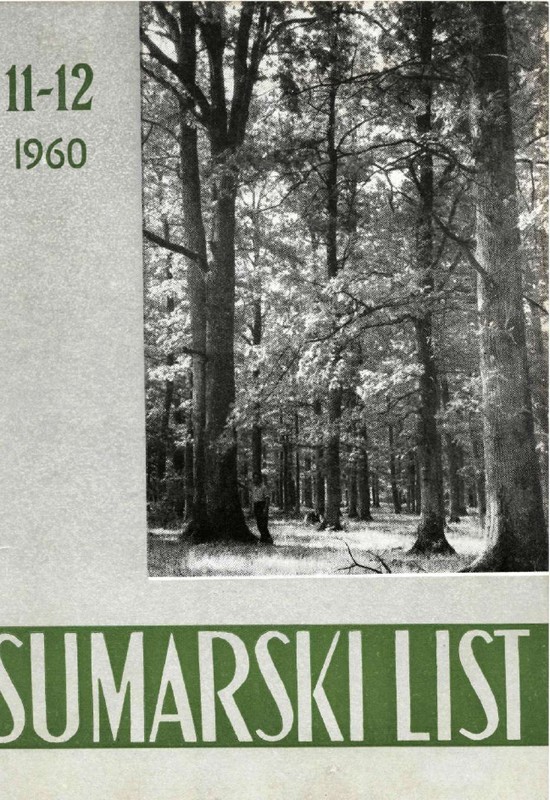
broj: 11-12/1960
pdf (12,4 MB) |
|
||||||||||||||
| DENDROMETRIJA | ||
| Emrović Borivoj | ||
| Double-entry volume tables for Silver Fir in Gorski Kotar region. PDF EN | 345 | |
| Summary: The German double-entry volume tables for Silver Fir - Abies alba (See Sichuberg [1]) give poor results in determining the timber volume in the area of Gorski Kotar (= mountaineous region in the western part of Croatia - between Zagreb and Rijeka). In this area the most important influence is played by the parent rock, and on the underlying silicate rock there grow predominatly the even-aged forests while on the calcareous parent rock the selection forests. Schuberg´s Tables yield for the trees from the silicate substratum (even-aged forests) too small stem volumes, while for the trees from the calcareous substratum too large ones. On the basis of 424 sample trees from the silicate subsoil and 126 trees from the calcareous were prepared tables separately for the silicate und separately for the calcareous subsoil (See Tables 4 and 5). The adjustment of volume was carried out by the method of least squares using the Schumacher-Hall´s formula (See Schumacher-Hall [2]). The parameters of the adjustment equations are compared with the parameters calculated from Schuberg´s Tables ("Derbholz") for different ages (see Table 2). The errors of parameters oa and ob are relatively high which means that the preparation of tables requires a greater number of data (sample trees). The volume (and consequently also the form factors) of trees from the silicate substratum (even-aged forest)are larger than those ones from the calcareous substratum (selection forest) which is understandable (See Table 3). It is interesting that the magnitude of parameter c is greater than 1, which means that the form factor increases when the height increases (on condition that the d. b. h. is the same). This fact is corroborated also by the analysis of the material taken from the silicate subsoil, which shows that the form quotient amounts approximately to q2 = 0´720 - 0´025 d - 0´035 h (d = diameter at breast height in cm., h = total height in m., q = form quotient i. e. the ratio between the diameter in total mid-height and d. b. h.), and - on the basis of the known high positive correlation between the form quotient and form factor - it is possible to conclude that the form factor f changes in a similar manner. The volume tables (See Tables 4 and 5) are of temporary character because they are unreliable owing to the too small number of data which served as their basis. Table 1 yields the data concerning the number of stems having served as the basis in the construction of volume tables. Date are grouped according to the diameter-height classes (d = diameter at breast height in cm., h = total height in m.) A, B. C, and D are the numbers of stems used for Schuberg´s Tables for "Derbholz" (timber > 7 cm. top diameter) for age classes ranging 21-40, 41-80, 81-120, and over 120 years respectively; E and F are the numbers of stems representing the basis for the preparation of volume table for Silver Fir at Zalesina on the silicate and calcareous parent rook. Table 2 gives the parameters for the Schumacher-Hall´s equation used for the smoothing of 5 Schuberg´s tables as well as for 2 tables from Zalesina. Table 3 gives an extract from different tables (d = diameter at breast height in cm., h = total height in m.); information given refers to the volume in cu. m.; A, B, C, and D refer to Schuberg´s Tables for "Derbholz" (Derbholzmassentafeln"); K means Schuberg´s Table for the total volume including needles (Baumholzmassen-tafeln"); F and G mean stem volume ("Schaftholz") for Silver Fir from Zalesina (Experimental forests of the Zagreb Forestry Faculty) obtained on silicate (even-aged forest) and on calcareous substratum (selection forest). Tables 4 and 5 represent the new - temporary - volume tables for Silver Fir on silicate parent rock (even-aged type of forest) and on calcareous parent rock (selection type of forest) respectively, (d = diameter at breast height over bark in cm., h = total height in m., m = stem volume with bark in cu. m.). The stump height is equal to 1/3 of d. b. h. | ||
| ISKORIŠČAVANJE ŠUMA | ||
| Bađun Stanko | ||
| The effect of blue-stain on the techncal properties of wood. PDF EN | 357 | |
| ZAŠTITA ŠUMA | ||
| Mikloš Ivan | ||
| Pygaera anastomosis L. — a new insect pest on Poplars. PDF EN | 369 | |
| UZGAJANJE ŠUMA | ||
| Zmijanac Đuro | ||
| Some diriections for the cultivation of forest tree species in plantations. PDF EN | 371 | |
| Žetko Alojz | ||
| Successful sowing by hand of the Austrian Pine in the Karst region. PDF | 379 | |
| Piškorić Oskar | ||
| Douglas Fir (Pseudotsuga Douglasii Carr.) as one of the species constituting the productive stands in the degraded part of the Karst region. PDF EN | 383 | |


